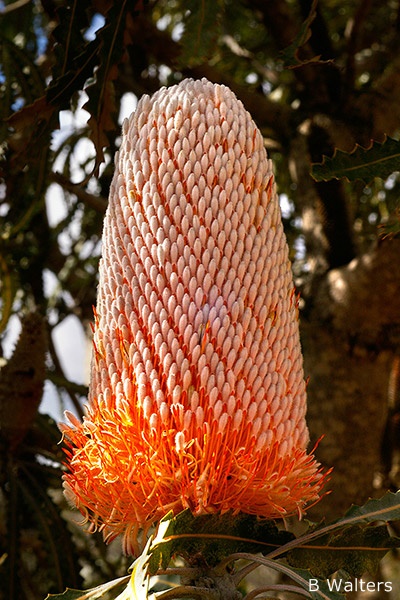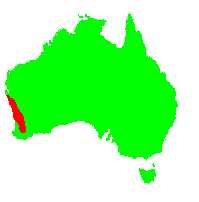General Description:
The acorn banksia (Banksia prionotes) is a common and widespread species. Around Perth, it is often a tall shrub or small tree to about 10 metres. Around Eneabba, plants are generally smaller and more spreading in habit, generally reaching around 4 metres or so. The leaves are linear, about 150-300 mm long by 20 mm wide and have deeply serrated margins. The cylindrical flower spikes are conspicuous as they occur at the end of the branches (terminal). They have a distinct “acorn shape” as the flowers open and are orange in colour about 100-150 mm long by 80 mm diameter. Flowering is usually during autumn and winter. The seeds are enclosed in follicles attached to a woody cone and are generally retained within the cone until burnt.
This species is fire-sensitive in that it does not have a lignotuber. It therefore cannot regenerate vegetatively after being burnt in a bushfire and relies on seed for regeneration.
Banksia prionotes is an outstanding ornamental species and ideal for cut flower production due to its bright coloured, terminal flowers. It is suited to cultivation in areas with a dry summer climate but is difficult to maintain in areas of high summer humidity. It requires well drained soils in full sun to light shade and tolerates at least moderate frost. Like all banksias, it is excellent for attracting honey eating birds.
B.prionotes has been known to hybridize with B.hookeriana in the wild in locations where both plants occur, as happens on the Eneabba plain.
Propagation of from seed is relatively easy but cuttings may be difficult to strike. Some of the acorn banksia group, which also includes B.burdettii and B.hookeriana have been successfully grafted onto Banksia integrifolia and B.serrata.

Banksia prionotes
Photo: Brian Walters
 Australian Native Plants Society (Australia)
Australian Native Plants Society (Australia)